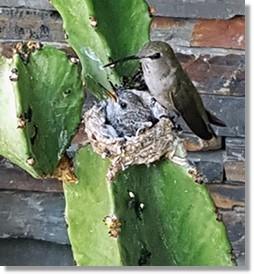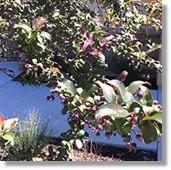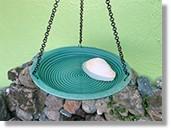Winter 2021-22
Creating a Wildlife Habitat

by Kathleen Gage
“In his book Bringing Nature Home, entomologist Douglas Tallamy gives notice: ‘It has become increasingly clear that much of our wildlife will not be able to survive unless food, shelter and nest sites can be found in suburban habitats.’ And which plants we choose to grow, Tallamy points out, determines the diversity in the numbers of wildlife that a particular garden can sustain.” From The California Wildlife Habitat Garden by Nancy Bauer.
When we create a new wildlife habitat in our home garden for birds, bees, butterflies and other wildlife, we are replacing—in a small but essential way—the habitats that had been lost to development, urban sprawl and agriculture. To create this wildlife environment, we need to shift our focus from traditional garden design of lawns, trimmed shrubs and neat flowerbeds. When we plant to also benefit wildlife in our garden, we begin to see that our home garden is a living, changing complex community that will bring us hours of pleasure.
“Discovering the native plants where you live can … define a unique sense of place and heritage for your garden habitat while preserving the natural history of the flora and fauna of your region.” From National Wildlife Federation: https://www.nwf.org/Garden-for-Wildlife/About/Native-Plants
In previous publications we discussed pollinator gardens for bees and butterflies extensively. In this article we will be focusing on attracting birds to our gardens. Not only are many birds pollinators too, they also greatly help with weed control and reducing pest populations by eating a lot of harmful insects.

Food: Native plants are the best choice for our local wildlife, though many plants already in our gardens offer shelter and food as well. Birds, mammals, amphibians and pollinators are sustained by foods such as nectar, seeds, fruit, berries and invertebrates, all of which California natives provide in abundance. A vibrant garden contains a diversity of colorful perennials, shrubs and trees. The best time to plant natives in the garden is October through March, as they develop strong roots during the rainy season. As you fill your garden with California natives, you will begin to hear the spirited conversations of towhees, wrens, finches, robins and sparrows, just to name a few!
Shelter: Think of creating a sanctuary for your wildlife that provides cover, which is the vegetation that exists in your home garden. It includes areas for birds to perch or nest, as well as easy access to natural food sources. Trees and shrubs that are attractive as shelter and nesting sites are usually evergreen and dense. Contra Costa has many bird species, including raptors, owls, shorebirds and songbirds. By planting natives for food and shelter, you can also save money as you will use less soil amendment, fertilizer and water in your wildlife garden.

Water: All wildlife need sources of water. Make sure to offer wildlife access to water in your garden. One excellent example is a birdbath. A good birdbath mimics shallow puddles, which are nature’s birdbaths. It does not have to be store-bought; a dinner plate is always an option. Birds seem to prefer baths that are at ground level, but if you have cats in the neighborhood, raise the bath two or three feet off the ground and eliminate nearby hiding spots for predators. Read Kathleen Gage's entire article
~
Now that we are talking about wildlife and pollinators here is some Hot News! The Monarch population soared 4,900 percent since last year in a thrilling 2021 Western Migration!
